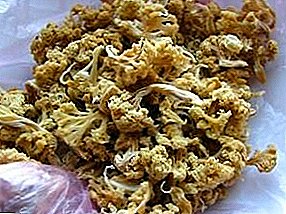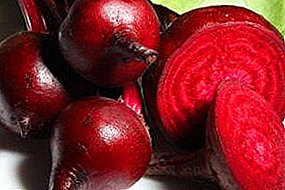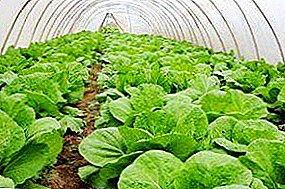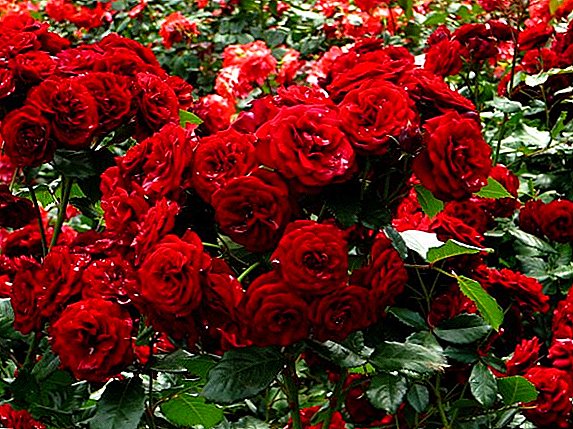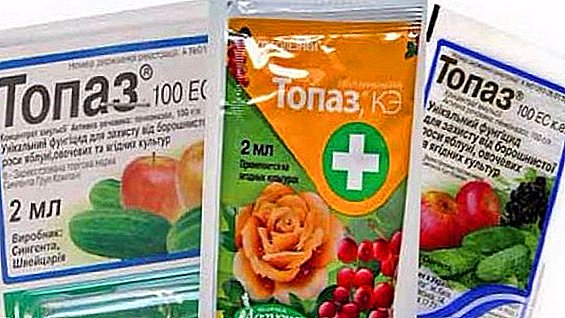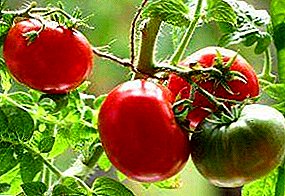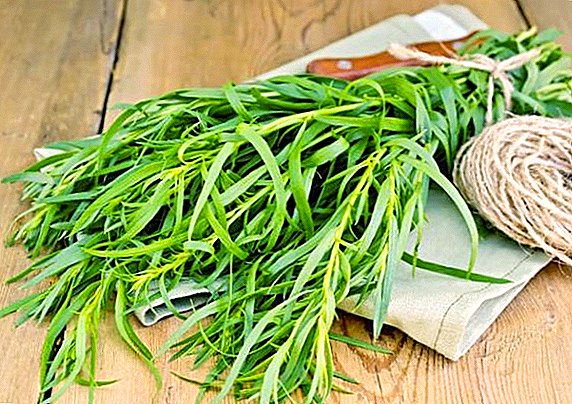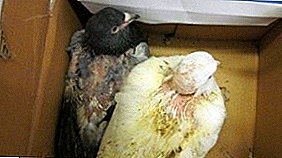 One of the favorite berry crops of gardeners is black currant. But over time, old varieties are increasingly sick, and also give a smaller number of fruits, the size of which is also reduced. There is a need for planting new varieties - such as, for example, the variety "Exotica". Let's take a closer look at its features and find out how to properly plant this currant and provide it with proper care.
One of the favorite berry crops of gardeners is black currant. But over time, old varieties are increasingly sick, and also give a smaller number of fruits, the size of which is also reduced. There is a need for planting new varieties - such as, for example, the variety "Exotica". Let's take a closer look at its features and find out how to properly plant this currant and provide it with proper care.
Selection
"Exotic", one of the largest varieties of black currant, bred in 1994 during the joint work of the All-Russian Research Institute for Breeding Fruit Crops and the Research Institute for Horticulture of Siberia. They created it from a seedling of the variety "Dove", a mixture of pollen from the varieties "Orloviya" and "Tearless". After several years of test cultivation, it was brought to the State Register in 2001. The authors of this variety are L. V. Bayanova, Z. S. Zolotov, T. P. Ogoltsova, and S. D. Knyazev. 
Description and characteristics
The appearance of "Exotica" makes a pleasant impression, as well as its quality.
Bush
The bushes of this currant are rather thick, grow straight, have thick light green shoots and large, rough five-lobed leaves with petioles of a gray shade. The surface of the leaves is wrinkled, shiny and leathery.
Currant brushes are small, straight and thick. The berries on them are thick, 8-10 pieces. Externally, the clusters of currants resemble bunches of grapes, which makes the harvesting process easier and faster.
Flower petals are white. The buds are pink, large, sit on a very short stalk, have an egg-shaped form.
Did you know? Black currant smell not only berries, but also leaves with branches, but the white and red varieties do not emit scent.
Berries
The berries are fragrant and round, spherical shape. Have a thin skin of black color and sweet-sour taste. By weight, fruits range from 3.5 to 5 g, and sometimes more cherry fruits are in size.  Currant aroma is very delicate and subtle. The taste of berries received a score of 4.4 points out of 5.
Currant aroma is very delicate and subtle. The taste of berries received a score of 4.4 points out of 5.
The content of vitamin C in this variety is particularly high - 197.1 mg per 100 g of berries.
Read also about the variety of black currants "Dachnitsa".
Some features of the variety
Besides the fact that the fruits of this currant are very large, it has a number of other advantages that are pleasant to the gardener.
Disease and pest resistance
"Exotica" has good resistance to the following pests and diseases:
- powdery mildew,
- septoria,
- columnar rust,
- terry
- kidney tick.
Currants are poorly resistant to anthracnose, which is why it needs to be sprayed with fungicides at least twice per season - before flowering and after picking berries.  Of particular danger are the aphid, glass bowl, gooseberry fire, currant leaf gallitsa and mites. To prevent their occurrence, the bushes during the growing season should be treated with the preparation BI-58 (10 ml per 10 liters of water).
Of particular danger are the aphid, glass bowl, gooseberry fire, currant leaf gallitsa and mites. To prevent their occurrence, the bushes during the growing season should be treated with the preparation BI-58 (10 ml per 10 liters of water).
Drought resistance and frost resistance
This variety is very sensitive to drought. If the summer is hot, the currant requires regular watering.
Important! The plant does not tolerate excessively humid climate. If it rains often - do not water the currants extra. This can cause the appearance of disease and rotting fruit.
"Exotica", since it was developed in Siberia, has a high frost resistance and can withstand temperatures down to -26 ° C.
Precocity and yield
This variety brings quite a large crop - 3.5 kilograms of selected currants from the bush. The special arrangement of the berries on the brush allows for mechanized harvesting. Early ripening and high yields make it especially attractive to entrepreneurs and ordinary gardeners.  “Exotica” is an early-ripening variety, the crop can be harvested at the beginning of July, but this means that it starts blooming too early. Frost, which can occur during flowering, can lead to a decrease in yield.
“Exotica” is an early-ripening variety, the crop can be harvested at the beginning of July, but this means that it starts blooming too early. Frost, which can occur during flowering, can lead to a decrease in yield.
Transportability
According to the criterion of transportability, this currant is rated 3.8 out of 5. Undervaluation is due to the fact that the berries have a thin skin. She often breaks during collection, and this leads to a decrease in shelf life and deterioration of the "Exotica" presentation.
If the fruit has a broken skin, it is well transported and stored for a very long time. At a temperature of 10-12 ° C currants stored for up to 10 days. If you pack it in a bag and keep it in the cold, from 0 to -1 ° С, you can store it for 1.5 months. With a deep freeze, the shelf life is extended for several months.
Using
Berries "Exotica" are suitable both for sale on the market, and for home cooking. Excellent for this variety for fresh consumption. The pulp of the currant is juicy, which makes it possible to make from it delicious jams, preserves, compotes, juice, fillings for pies or dumplings, healthy smoothies.  Skillful gardeners will be able to make it even a great currant liqueur.
Skillful gardeners will be able to make it even a great currant liqueur.
Familiarize yourself with black currant preparation recipes: currants ground with sugar, jam, five-minute jam, tincture of vodka, moonshine and alcohol, wine.
How to choose seedlings when buying
It is best to buy a seedling in a nursery or a specialized garden store. So you can avoid changing the variety or infection of the plant with infection and insects.
When inspecting the seedling, it is important to pay attention to the fact that the roots are lignified. A seedling should have at least 3 basic roots with a length of at least 20 cm. The root system should be strong, without damages or rotten parts. Shoots - strong and resilient.
Important! The bark on the shoots should be without damage, dense, having a uniform color.
The two-year sapling will take root best. 
Choosing a place
For landing "Exotics" you need to choose a sunny, warm place. It is important that there is no stagnation of air. But even more important is the protection of the bush from the harsh northern wind. Groundwater in the selected area should be from 2 meters under the ground and deeper. Such a distance to them will positively affect the development of a strong root system in a plant.
"Exotica" lives and develops well on soil with low acidity (pH not higher than 5.5). If the acidity level is higher, it is advisable to chill the soil. To do this, depending on the acidity, per square meter of soil contribute up to 300 to 700 g of lime in the powder.
Important! If the bush will not get enough heat and sun, the shoots will stretch much up, and the berries will be very small.
Time and landing scheme
Planting time depends on the type of seedling. If the plant was purchased with an open root system, it should be planted in early October. This need is caused by the fact that the root system needs to adapt to the soil before the onset of cold weather. But after winter, such a currant will immediately begin to grow, since it has become accustomed to the soil.
If the seedling was purchased in a container, it is planted in the spring. It is transplanted directly with a clod of earth and does not take time to adapt to the new conditions.  Site preparation for planting currants involves leveling the site and removing all weeds. It is better to dig holes for bushes in advance - 14 days before the landing day. The pit should have a size that is twice the size of the seedling's root system. The standard is 50 cm wide and 40 cm deep.
Site preparation for planting currants involves leveling the site and removing all weeds. It is better to dig holes for bushes in advance - 14 days before the landing day. The pit should have a size that is twice the size of the seedling's root system. The standard is 50 cm wide and 40 cm deep.
Learn more about the intricacies of planting currants in the fall and spring.
The distance between currant bushes or between the bush and the fence (wall) must be at least 1 meter. If a part of the bush has obstacles to growth, it will not yield a crop. The maximum distance to another bush or wall is 1.3 meters.  Step-by-step landing process:
Step-by-step landing process:
- Add fertilizer and nutrients to the pits. For this, it is best to use 1 bucket of compost, 200 g of superphosphate and 300 g of wood ash. All this mixture is mixed with a small amount of earth and introduced into each pit.
- Plant the Exotica under a slight incline and root the root neck by 7-10 cm. It is important to ensure that the three lower buds remain underground and the top 3 buds above it. The rest of the bush can be cut.
- Under the seedling pour 7 to 10 liters of water and prikatat bush with peat soil, which will help to retain moisture better.
- Lightly tamp the ground.
Did you know? To increase the yield and weight of the berries "Exotics", gardeners use such cunning: several other varieties of currant are planted next to it, so that they cross-pollinated.
Basics of seasonal care
After planting, it remains only to properly care for the bush in order to achieve the earliest and largest crop.
Watering
"Exotica" loves water very much. Its health and the amount of the future harvest directly depend on this factor. If the bush lacks moisture, its growth will slow down, the berries will become small and can crumble.  Irrigation scheme:
Irrigation scheme:
- first watering - at the beginning of the growth of shoots and the appearance of the ovary;
- the second is when the berry is poured;
- the third is when the harvest is gathered;
- the fourth - in the autumn, if there is a small amount of rain.
Important! The need for watering can be easily identified by digging up the soil next to the bush. If it is dry - you need to additionally water it.
To irrigate more efficiently, you need to make grooves around the bush at a distance of 40 cm and pour water into them. The depth of the grooves is 15 cm. This method of irrigation consumes from 30 to 50 liters per square meter of soil.
Soil care
Caring for the soil, where "Exotica" grows, is quite simple:
- monitor the weeds and remove them;
- loosen and mulch the soil under a bush after watering;
- at the end of May, fill the ground under the bush with compost, fresh grass or peat to preserve the looseness of the ground, protect it from overheating and preserve moisture.
We advise you to read about seasonal care of the currants in the spring and autumn.
Top dressing
The first two years do not need to fertilize the bush - currants still receive the necessary vitamins and elements from fertilizers applied during planting.  After this time, the bushes are fed three times a year:
After this time, the bushes are fed three times a year:
- at the end of March, a mixture of water and chicken manure is poured under the bush (10 liters per 100 g respectively) or 50 g of urea;
- in May, the bush is watered with a solution of nitroammofoski - 150 g of the substance are used for 10 liters of water;
- in October, a mixture of humus and ash (1 bucket per 1 cup, respectively) or a humus bucket with 10-20 g of potassium sulfate and 50 g of superphosphate are introduced.
In order for fresh shoots to go through the process of lignification and not to freeze in the cold, in the fall nitrogen fertilizer is not applied to the soil.
Read tips on feeding currants in the spring.
Pruning
The bush "Exotic" will be healthy and fertile, if you cut it in time and correctly. That is why already at planting only the strongest and strongest shoots are left - no more than 4 pieces. After 2 years from the date of planting, the weakest, damaged and dry shoots are removed again. Now you need to leave no more than 5 shoots on each bush.
After four years of currant life, only old, dry and infertile shoots can be cut, leaving any number of strong shoots. This pruning will need to be carried out every year until the death of the plant.  In order for the cut to be even and the branches' tissues not crumpled and not injured, you need to keep the pruner with the cutting side in the direction to the part of the shoot that will be left.
In order for the cut to be even and the branches' tissues not crumpled and not injured, you need to keep the pruner with the cutting side in the direction to the part of the shoot that will be left.
Did you know? Currant does not grow only in Australia and Antarctica.
Winter cold protection
Siberian variety, so it can withstand severe frosts. However, in order for the bush to quickly move away from winter in the spring, it is still necessary to make some efforts.
At the end of October you need:
- Trim the plant.
- Fertilize the soil and carefully dig it in order to avoid damage to the root system.
- Promulgate the area near the trunk with hay, sawdust, peat or dry leaves.
- If frost is expected to be more than -26 ° C, you need to wrap a bush with a strong rope and cover it with cardboard or specialized material.

Advantages and disadvantages
The obvious advantages of the variety "Exotica" are:
- large size of berries;
- resistance to some pests and diseases characteristic of this crop;
- good frost resistance;
- high and early yield;
- marketable condition;
- good transportability;
- relatively long shelf life of berries.
"Exotica" also has several disadvantages:
- does not tolerate severe drought;
- due to early flowering may freeze;
- poorly resistant to terry, anthracnose, kidney mite and septorioza;
- ripe berries do not hold until harvesting, and showered;
- the berries have a thin peel, which increases the risk of breaking the shell and loss of juice;
- does not tolerate strong moisture.
Video: black currant "Exotica"
Reviews on a grade of currant "Exotica"


Ideal plants do not happen - each variety has its pros and cons. Sort "Exotica" clearly has more advantages than disadvantages, and this attracts the attention of gardeners, both professionals and amateurs. With the right choice of planting place and proper care of the plant, "Exotica" will annually please the host with a useful harvest.


